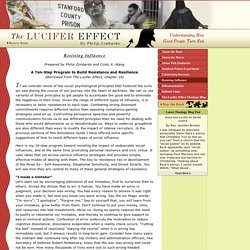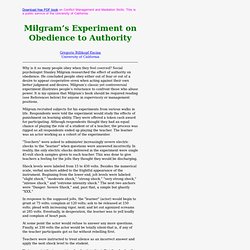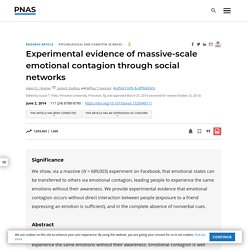

Untitled. History of Social Psychology. Social Psychology timeline. Timeline: Social Psychology Pioneers - Understanding and Overcoming Hate. Links on the History of Psychology. Jonathan Haidt Social Psychology of Morality. The Lucifer Effect by Philip Zimbardo. Prepared by Philip Zimbardo and Cindy X.

Wang A Ten-Step Program to Build Resistance and Resilience(Borrowed from The Lucifer Effect, Chapter 16) f we consider some of the social psychological principles that fostered the evils we saw during the course of our journey into the heart of darkness. We can us use variants of those principles to get people to accentuate the good and to eliminate the negatives in their lives. Given the range of different types of influence, it is necessary to tailor resistances to each type.
Here is my 10-step program toward resisting the impact of undesirable social influences, and at the same time promoting personal resilience and civic virtue. “I made a mistake!” “I am mindful.” “I am responsible.” “I am Me, the best I can be.” “I respect Just Authority, but Rebel against Unjust Authority.” “I want group acceptance, but value my independence.”
Psy105-Classic Social Psychology Experiments - List. Psychology History. Compiled by Robin Stock (Dec 1999) Biography Theory Time Line Bibliography The study of Social Psychology emerged between 1908 and 1924.

Muzafer Sherif, one of the founders of social psychology, stands out as one of the main forces behind its growth in the in the 30's (Baron, Byrne 1997). His work with group processes and inner group conflict following social norms still serves as a reference point to researchers studying groups today. On July 29, 1906 in Odemis, Izmir, Turkey, Muzafer Serif Basoglu, who later changed his name to Muzafer Sherif, was born the second child of five to a fairly wealthy family.
After obtaining his Ph.D. he went to teach at Ankara University in Turkey where, with the help of students, he translated some important psychology works into the Turkish Language. Throughout his career at various colleges and organizations, he worked in a variety of roles: assistant professor of psychology, professor of psychology, U.S. Theory Time Line Bibliography. The Perils of Obedience ~ An Essay Response. A staple for first year psychology students is a discussion of the famous Milgram experiment . Dr. Stanley Milgram was a social psychologist at Yale University deeply interested in the behavior of obedience. The Nazi war crimes trials in particular inspired his exploration of how humans develop the capacity to commit atrocities, and then excuse themselves because they were only “following orders”. The Doctor devised a method to test ordinary people to see if they would commit acts against their conscience. His controversial psychological experiment presumed to test memory in word associations, but involved a key deception; the authority figure issuing orders was not really a doctor, and volunteers did not know the ‘student’ subject strapped to an electric chair was in fact an actor pretending to respond to electric shocks generated by the 'teacher' volunteer whose hand was on the controls.
The test focus of course was on the 'teacher' administrating the “punishment”. Sherif et al. (1954/1961) Index. Milgram's Experiment on Obedience to Authority. Download free PDF book on Conflict Management and Mediation Skills.

This is a public service of the University of California. Milgram’s Experiment on Obedience to Authority Gregorio Billikopf Encina University of California Why is it so many people obey when they feel coerced? Social psychologist Stanley Milgram researched the effect of authority on obedience. Milgram recruited subjects for his experiments from various walks in life. What Milgram’s Shock Experiments Really Mean. In 2010 I worked on a Dateline NBC television special replicating classic psychology experiments, one of which was Stanley Milgram's famous shock experiments from the 1960s.

We followed Milgram's protocols precisely: subjects read a list of paired words to a “learner” (an actor named Tyler), then presented the first word of each pair again. Each time Tyler gave an incorrect matched word, our subjects were instructed by an authority figure (an actor named Jeremy) to deliver an electric shock from a box with toggle switches that ranged in 15-volt increments up to 450 volts (no shocks were actually delivered). In Milgram's original experiments, 65 percent of subjects went all the way to the end. We had only two days to film this segment of the show (you can see all our experiments at so there was time for just six subjects, who thought they were auditioning for a new reality show called What a Pain!
SCIENTIFIC AMERICAN ONLINEComment on this article at ScientificAmerican.com/nov2012. Milgram's Obedience to Authority Experiment 2009 1/3. Philip G. Zimbardo. Stanford Prison Experiment. The Stanford Prison Experiment: A Simulation Study of the Psychology of Imprisonment.
Follow-Up Studies to Milgram's Obedience Experiment. Philip Zimbardo: The psychology of evil. French troops bullying German citizens. Ruhr Germany 1923. Experimental evidence of massive-scale emotional contagion through social networks. Author Affiliations Edited by Susan T.

Fiske, Princeton University, Princeton, NJ, and approved March 25, 2014 (received for review October 23, 2013) Significance We show, via a massive (N = 689,003) experiment on Facebook, that emotional states can be transferred to others via emotional contagion, leading people to experience the same emotions without their awareness. We provide experimental evidence that emotional contagion occurs without direct interaction between people (exposure to a friend expressing an emotion is sufficient), and in the complete absence of nonverbal cues.
Abstract Emotional states can be transferred to others via emotional contagion, leading people to experience the same emotions without their awareness. Emotional states can be transferred to others via emotional contagion, leading them to experience the same emotions as those around them. Three studies have laid the groundwork for testing these processes via Facebook, the largest online social network. Fig. 1. PNAS 2014 Kramer 8788 90. Milgram. Roger hock forty studies that changed psychology 6th edition. The History of Social Psychology.